
Masonry may deteriorate, crack, delaminate and fail for a variety of reasons. Many of these problems can be overcome by using various combinations of remedial ties and masonry reinforcement products and techniques.
The illustration shows a typical two storey Victorian property of solid wall construction with a later cavity wall extension.
Highlighted are some of the most commonly occurring structural faults that affect every type of commercial and residential property of all ages and construction. In conjunction with the other products are able to remedy specific problems.
These are installed externally in the vast majority of situations leaving buildings visibly unimpaired and causing negligible disruption to their occupants.
Clearly there are other situations which are not shown here such as failed parapet walls, separated cornices, blown render and many more besides.
Using various combinations of ties, fixings and reinforcing rods virtually any situation can be dealt with so do not hesitate to call us if you have a particular problem which is not covered here.

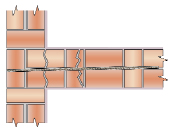 |
1. Reconnectioning Party wall with external walls.CemTies are installed simultaneously with HeliBond MM2 grout into angled clearance holes drilled, to the required depth, through the external wall and into the party wall. |
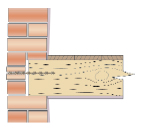 |
2. Stabilising Bowed Walls into Joist Ends.BowTies are inserted through a clearance hole in the masonry and power driven directly into the joist end before bonding with PolyPlus resin into the masonry. |
 |
3. Repair of Bay Windows.Twin HeliBars are bonded into a predetermined cut slot around the bay above the window with the ends embedded in the front elevation. BowTies are driven into the joist ends via clearance holes in the masonry and low level cracks are stitched with single HeliBars. |
 |
4. Repairing Separated Masonry.CemTies and HeliBond grout are installed into clearance holes drilled through the near leaf and at least 75mm into the far leaf. The density of the ties will depend upon the degree of separation, the material, the cause and the condition of the masonry overall. |
 |
5. Reconnecting Internal Walls with External Walls.Predetermined slots on the internal wall are channeled out to the specified length right into the corner. Angled holes of 10mm are drilled from the corner into the external wall. Single lengths of HeliBar are bent to shape with the angled end being PolyPlus resin bonded into the hole and the remainder HeliBond grouted into |
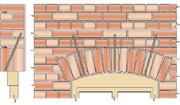 |
6. Repairing Brick Arch Lintels.Parallel lengths of HeliBar rod are bonded into the specified cut slots directly above the existing lintel. Angled CemTies or DryFix ties are installed through the lintel and into the masonry above the lower HeliBars. |
 |
7. Repairing Brick Arch Lintels.Parallel lengths of HeliBar rod are bonded into the specified cut slots directly above the existing lintel. Angled CemTies or DryFix ties are installed through the lintel and into the masonry above the lower HeliBars. |
 |
8. Stabilising Bowed Walls into Joist Sides.BowTie HDs are inserted through clearance holes in the masonry and are power-driven through the first and second joist (and third, if required) before the outer end is bonded into the masonry with PolyPlus resin. |
 |
9. Creating Masonry Beams.The Helibeam System uses parallel lengths of HeliBar reinforcing bonded into predetermined cut slots (normally the mortar beds) with HeliBond grout to form deep masonry beams which distribute the building loads. A- shows a beam resisting the horizontal displacement of a bowing wall. Due to the internal stairwell BowTies cannot be used as there are no joists at this point. B- shows a beam resisting vertical loads to prevent building subsidence. |
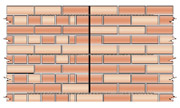 |
10. Crack Stitching.Lengths of HeliBar extending 500mm either side of the crack are bonded into cut slots, normally the mortar beds, with HeliBond or PolyPlus resin. |
 |
11. Creating Movement Joints.A 400mm HeliBar is installed across the joint, as with cracks, but is only bonded at one end. The other end is allowed to move freely by inserting it into a sleeve which is then bonded into the masonry. |
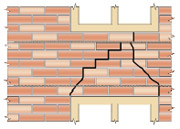 |
12. Repairing or creating flat arch lintels.Parallel lengths of HeliBar, are bonded into the specified cut slots above the existing lintel. |
 |
13. Replacing cavity wall ties.DryFix wall ties are power driven directly into both leaves, via a small pilot hole of around 6mm diameter. OR RetroTies are driven into a 4.5mm pilot hole in the far leaf, via a clearance hole in the near leaf into which they are bonded with PolyPlus. |
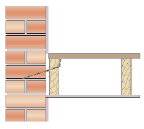 |
14. Ceiling Joist Pinning.RetroTie fixings are driven at an angle through the joist and into the masonry, via a small pilot hole, and the projecting end is hammered over. |

